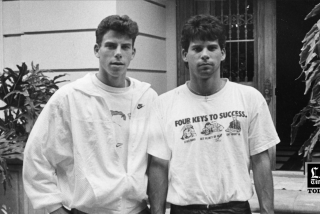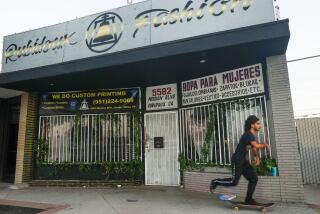9 Years Later, a Murder Case Goes to Jury : At Least One More Defendant Awaits Trial in Death of Grocer’s Wife
Nine years ago, John and Johann Seigman were living what prosecutor Tony Rackauckas calls “their share of the American dream”: A comfortable home in Rossmoor, financial security and three lovely children.
But that was shattered on Aug. 25, 1976, when two men barged into their home, kidnaped Mrs. Seigman and the children, and ordered John Seigman to empty the safe at the Market Basket grocery he managed in Long Beach in return for their safety. The children were later found unharmed. But his wife was found dead two days later in a field in Dominguez Hills, shot five times in the back of the head.
Today, a Superior Court jury in Westminster, which has been hearing the case for two months, is finally expected to begin deliberations in the trial for the first of two men accused of the kidnap-murder.
William Gullett, 35, of Bellflower, calmly read through legal papers Monday while Rackauckas summarized the case against him. He is accused of being one of the two men who entered the Seigman home. His co-defendant, Ronald Ewing, also 35 and from Bellflower, will be tried next month. Ewing is accused of driving the escape car for Gullett and of being the second man who entered the Seigman home.
A third suspect has not been arrested, but during the trial John Seigman identified from the witness stand a third man as Jack Bird, 43, of Garden Grove, a longtime friend of Ewing. Bird had been ordered by Judge Luis A. Cardenas to appear in court for the identification.
But Bird might not be prosecuted. Seigman and the three kidnaped children were all hypnotized after the incident to help them recall details. A state Supreme Court ruling since then, which virtually bars all testimony from hypnotized witnesses, would eliminate Seigman as a witness at a Bird trial. And Seigman is the only one who can identify Bird.
Because of the court’s hypnosis ruling, Seigman cannot testify against Ewing either. He was allowed to testify against Gullett only because the defense wanted his descriptions of the two intruders on the record.
Gullett and Ewing were arrested in 1976 just a few days after Johann Seigman’s body was found. But they were released several months later after Superior Court Judge H. Warren Knight ruled that a municipal judge had not found sufficient evidence to send them to trial.
Eight years passed before they were arrested again. But Rackauckas, an Orange County deputy district attorney, said the case was far from dormant during those years.
“It was an execution-style murder, and with a murder of that kind of gravity, we just don’t give up on it,” Rackauckas said following the January, 1984, arrests.
Gullett and Ewing were first arrested on the strength of a statement to police by Curt Eddy, who had met Gullett in prison. Eddy told police he was supposed to participate in the kidnap but backed out just a few hours before it occurred because Gullett and Ewing said they would probably have to kill the victims.
Eddy had a lengthy criminal record, however, and the district attorney’s office was worried it could not get a conviction without more evidence.
From early 1977 through mid-1983, the case was kept alive through interviews with potential witnesses and by keeping track of Gullett and Ewing. Gullett was in federal prison most of that time on a bank robbery conviction; Ewing was living in Montana.
In mid-1983, Rackauckas returned from a six-month leave of absence and one of his first assignments from Chief Homicide Prosecutor James Enright was to review the Gullett-Ewing file and see if a case could be put together.
Rackauckas decided to try to bring the two to trial again. But the credit, he said, goes to Orange County Sheriff’s Investigator Stan Kinkade “who spent thousands of hours putting this case together, running down hundreds of witnesses just to find out if they were still around or even alive.”
Rackauckas’ case against Gullett centers on three men who testified that Gullett incriminated himself:
- Eddy, who testified for three days that Gullett checked out the Market Basket as a place to rob but made a final decision on it after discovering Seigman’s name and home address in the telephone book. Eddy said he became acquainted with Gullett in state prison, where Gullett was serving time for robbery and Eddy for burglary.
In closing arguments Monday, Rackauckas acknowledged that the jurors might not want a convicted burglar living next door to them. But he said that Eddy’s testimony was still reliable.
“You don’t go to choir boys to help you plan a kidnaping,” Rackauckas told the jurors. He pointed out that no one forced Eddy to go to the police in 1976.
- Fred Rolfe, who was in federal prison with Gullett and testified that Gullett told him about participating in a kidnaping in California in which a woman victim was shot to death.
- James D. Cochrum, who has been a jail informant in several other Orange County murder cases. Cochrum testified that he overheard Ewing and Gullett arguing in the jail, with Ewing blaming Gullett for the trouble they were in because Gullett had talked to Rolfe in prison.
According to Cochrum’s testimony, Gullett answered: “Well, you were the one who insisted we kill her.”
Gullett’s attorney, Marvin Cooper, argued to jurors that Seigman’s description to police of the two who entered his home in 1976 did not match Gullett’s description. He also attacked the credibility of Rackauckas’ three main witnesses because of their criminal backgrounds.
Gullett, if convicted, could face a maximum sentence of life in prison without parole because the kidnaping of Mrs. Seigman involved great bodily injury. He cannot get a death sentence, however, because the crime occurred two years before the state Supreme Court declared the death penalty unconstitutional and new court procedures were adopted.
More to Read
Sign up for Essential California
The most important California stories and recommendations in your inbox every morning.
You may occasionally receive promotional content from the Los Angeles Times.










